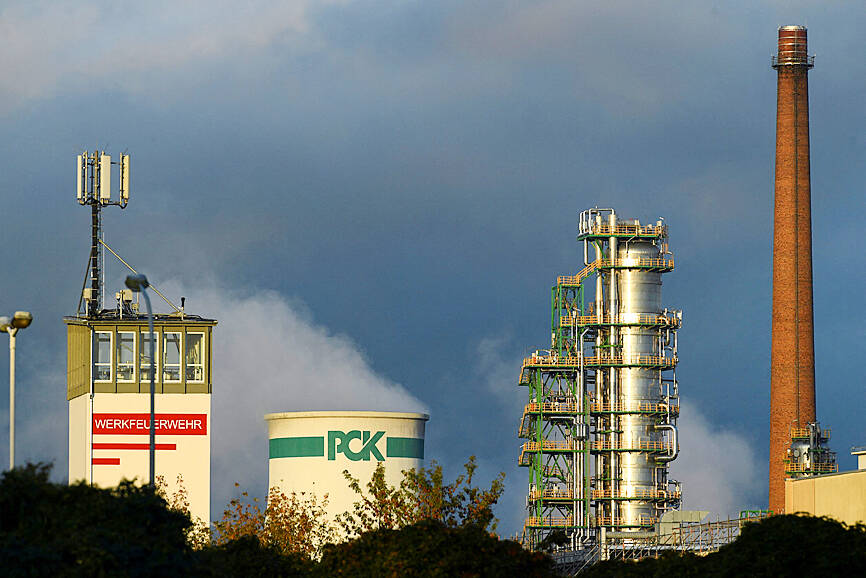Oil recorded its first weekly loss in a month after erasing most of the gains stemming from OPEC+’s surprise output cut.
Brent crude wiped out almost all of the US$7 that it gained after OPEC and its allies blindsided markets with a pledge to cut production.
Brent crude for June delivery rose 0.69 percent to US$81.66 a barrel on Friday, but posted a weekly decline of 5.39 percent.

Photo: Reuters
West Texas Intermediate for May delivery gained 0.65 percent to US$77.87 a barrel, dropping 5.63 percent from a week earlier.
Global supplies are showing signs of growth with Russia’s crude exports bouncing back above 3 million barrels a day last week, while in global fuel markets, gasoline and diesel are slowing at a time when they should be increasing or peaking.
Asian refiners are considering cutting volumes as margins have weakened recently, signaling that refineries did not manage to pass on higher costs to consumers.
“It appears that some of the excitement around the OPEC+ cuts has faded, amid light flows,” Standard Chartered PLC executive director of energy research Emily Ashford said.
Technical indicators also took a toll on prices. The US benchmark failed to break through its 200-day moving average last week and has been trading lower ever since.
The US$7 jump in prices after the OPEC+ announcement created a so-called chart gap, which then prompted a corrective move to the downside to fill the large break in prices.
Last month oil hit a 15-month low in the aftermath of bank turmoil that shook confidence across all markets. The combination of the surprise announcement by OPEC+ on production cuts coupled with a reduction in Iraqi flows pushed oil back into the US$80 range.
Many market watchers are still betting on a rebound in demand from China, which grew its economy at the fastest pace in a year, putting the country on track to reach its growth goal.
Additional reporting by staff writer

Semiconductor business between Taiwan and the US is a “win-win” model for both sides given the high level of complementarity, the government said yesterday responding to tariff threats from US President Donald Trump. Home to the world’s largest contract chipmaker, Taiwan Semiconductor Manufacturing Co (TSMC, 台積電), Taiwan is a key link in the global technology supply chain for companies such as Apple Inc and Nvidia Corp. Trump said on Monday he plans to impose tariffs on imported chips, pharmaceuticals and steel in an effort to get the producers to make them in the US. “Taiwan and the US semiconductor and other technology industries

SMALL AND EFFICIENT: The Chinese AI app’s initial success has spurred worries in the US that its tech giants’ massive AI spending needs re-evaluation, a market strategist said Chinese artificial intelligence (AI) start-up DeepSeek’s (深度求索) eponymous AI assistant rocketed to the top of Apple Inc’s iPhone download charts, stirring doubts in Silicon Valley about the strength of the US’ technological dominance. The app’s underlying AI model is widely seen as competitive with OpenAI and Meta Platforms Inc’s latest. Its claim that it cost much less to train and develop triggered share moves across Asia’s supply chain. Chinese tech firms linked to DeepSeek, such as Iflytek Co (科大訊飛), surged yesterday, while chipmaking tool makers like Advantest Corp slumped on the potential threat to demand for Nvidia Corp’s AI accelerators. US stock

SUBSIDIES: The nominee for commerce secretary indicated the Trump administration wants to put its stamp on the plan, but not unravel it entirely US President Donald Trump’s pick to lead the agency in charge of a US$52 billion semiconductor subsidy program declined to give it unqualified support, raising questions about the disbursement of funds to companies like Intel Corp and Taiwan Semiconductor Manufacturing Co (台積電). “I can’t say that I can honor something I haven’t read,” Howard Lutnick, Trump’s nominee for commerce secretary, said of the binding CHIPS and Science Act awards in a confirmation hearing on Wednesday. “To the extent monies have been disbursed, I would commit to rigorously enforcing documents that have been signed by those companies to make sure we get

UNUSUAL TIMING: The success of DeepSeek has prompted a scramble among its domestic competitors to upgrade their own AI models Chinese technology company Alibaba Group Holding Ltd (阿里巴巴) yesterday released a new version of its Qwen 2.5 artificial intelligence (AI) model that it said surpassed the highly acclaimed DeepSeek-V3. The unusual timing of the Qwen 2.5-Max’s release, on the first day of the Lunar New Year when most Chinese people are off work and with their families, points to the pressure Chinese AI start-up DeepSeek’s (深度求索) meteoric rise in the past three weeks has placed on not just overseas rivals, but also its domestic competition. “Qwen 2.5-Max outperforms ... almost across the board GPT-4o, DeepSeek-V3 and Llama-3.1-405B,” Alibaba’s cloud unit said in